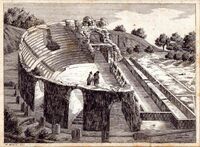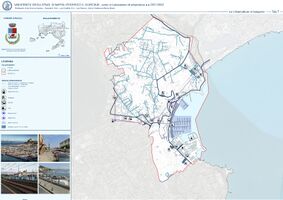Baia Wave Living Lab 2022: Difference between revisions
Jump to navigation
Jump to search
No edit summary |
|||
| Line 129: | Line 129: | ||
<gallery widths="500" heights="200" perrow="5"> | <gallery widths="500" heights="200" perrow="5"> | ||
File: | File:Connections.jpg | ||
File:Port view.jpg | |||
File:View of the port.jpg | File:View of the port.jpg | ||
</gallery> | </gallery> | ||
Revision as of 20:44, 17 May 2022
>>>back to working groups overview
| Area | Baia | |
| Place | Bacoli | |
| Country | Italy | |
| Topics | Cultural heritage, submerged archeology and volcanic landscapes. | |
| Author(s) | Mohammad Amiri, Eleonora D'Anna, Valeed Abdulhamid, Maria Ferraro, Himanshu Kasera | |
Rationale
- Why do you think this case is relevant? What is your hypothesis considering the landscape challenges?
- Format: 3-4 sentences
Location and scope
You can edit this map with the map editor
Water as a natural system
Geomorphology, typologies and dynamics of water areas
- Describe the water areas of your area in the contxt of the wider water system
- How does water appear in the landscape of your living lab? What types of water areas are common?
- Please identify the water bodies' catchment areas, tributaries and floodplains
- Which dynamics do these water areas have?
- Have there been any flood events in the past?
- add 2-3 graphical representations to the image gallery, you can add more if you like
- try to use drawings that express the system dynamics
- Yourcase watersystem1.jpg
add a caption
- Yourcase watersystem2.jpg
add a caption
- Yourcase watersystem3.jpg
add a caption
Water as a living space
- Which habitats can be found in and along the water areas of your area?
- How is the water quality in your water areas?
- Which areas are still natural, which are urbanized/artificial?
- Your case green blue infrastructure1.jpg
add a caption
- Your case green blue infrastructure2.jpg
add a caption
Blue and Green Infrastructure
- What are the major potential elements of a green/blue infrastructure network? Are these likely to change/disappear? Why is that?
- You find my background material on green infrastructure in our reading list
- add 1-2 graphical representations to the image gallery, you can add more if you like
- Your case green blue infrastructure1.jpg
add a caption
- Your case green blue infrastructure2.jpg
add a caption
Water as a cultural space
Land use and water
- In the early days of the Roman Empire, Baia, known as "little Rome," became the summer residence of the emperors, thus also the court moved there, and the area became even more luxurious. After Augustus the thermal baths of Baia were extended by Nerone, Adriano, Antonio Pio, and Alessandro Severo, until it became an immense thermal city. Large buildings were built for baths, gymnasiums, libraries, and porticoed gardens. Indeed, porticoes became a feature of the place, supporting the vast terraces that reached out toward the sea, also allowing protection from thunderstorms or the great summer heat. Nowadays remain few original ruins of ancient Baia because of bradyseismic events that have hidden underwater the most valuable and ancient part of the town. Excavations began in 1941, they were interrupted because of the war and resumed in 1950 with Prof. Amedeo Maiuri.
- Even today the coast of Baia is a great resource, not only because it represents a vacation spot for the population but also because with the advent of technological development, tourism has been implemented. Indeed, the port represents both a key resource on a commercial level and a connection point with the islands of Procida and Ischia.
Cultural and spatial typologies of water areas
- The ancient roman city of Baia was born along the cost, about 2400 years ago the current port was largely occupied by the mainland, and the promontories of “Punta dell'Epitaffio” and “Punta del Castello” closed forming a basin, called the “Lacus Baianum”. Today a part of this territory is collapsed under the sea because of the phenomenon of bradyseism. This city doesn’t have a regular path and its main area is situated along the coast, where there are the principal commercial activities, the port and an industrial area that contains some abandoned buildings while some others are still in operation. The historical part of Baia is connected to the archaeological one, indeed the little square, which represent the heart of this place, overlooks the Temple of Diana. Moreover, this site is famous all over the word not only thanks to all the roman ruins located on the inner area, but also for the underwater archaeological park, which is one of the favorite tourist destinations. The main street “Via Lucullo” separates the port area form the historical ones and from the agricultural part which is located on the north area of the territory in which residential villages servs plantations.
Sacred spaces and heritage
- Which places/elements hold cultural value and to whom?
- You may add a map and some images, please also explain in your caption why these elements are valuable
- Your case sacredspace1.jpg
add a caption
- Your case sacredspace2.jpg
add a caption
- Your case sacredspace3.jpg
add a caption
Visual appearance and landscape narrative
- Which elements are essential for the landscape character?
- Has the landscape been painted or otherwise depicted, when and whom? Which elements are essential?
- Which narratives exist? Who has written about this landscape or depicted it in some way?
- You can add text and images
- Your case character1.jpg
add a caption
- Your case character2.jpg
add a caption
- Your case character3.jpg
add a caption
Water and People
Accessibility and usability
- The coast is washed by Tyrrhenian Sea and partially occupied by the port, which has a direct access to the sea, in order to simplify the network of harbor transports. The port area is generally populated by locals and tourists which rent boats, especially during summer. This phenomenon causes lots of problems, firstly because these means of transport pollute the waters of the sea and also, because the frequent marine traffic deteriorate the near submerged archaeological remains that lie down the seabed.
- Another part of the coast, instead, is occupied by small fragments of beach, that are interrupted by parkings and restaurants which make it hard to reach the shore. Moreover, the difficulties in accessing are caused by a difference in altitude between the beach and the street that crosses the entire coast; they can be overcome only with flights of stairs and ramps. People use this space not for bathing, because it’s unsuitable for swimming, but to enjoy the beach and take courses for diving to see the underwater remains.
Community Mapping
What is to be mapped here?
- Social groups from within the community, for example the youth, kids, students, parents, the retired etc. Typically, these groups have specific needs, which you can also make explicit on the map. These people might not be organized in any way, but they are usually present in the context you are observing
- Local stakeholder groups: these groups are organized in one or the other way. They only exist within the community context you are observing. For example: the local community center, local churches, local interest groups, the landowners, small businesses and retailers
- External stakeholder groups are not necessarily present in the environment you are observing, but they may have strong stakes and interests. These can be local authorities, politicians, associations, care services etc.
- For each group, you may identify their needs, objectives, power and capacities
- You may also identify gaps and power conflicts
- Please try to redepict these elements in an integrated way and in relation to your water landscape. What is the relationship between these groups? Are they close or distanced from each other? Who is more powerful? Which voices are hardly heard? Do they have any shared concerns?
- Your case your community map1.jpg
add a caption
- Your case your community map2.jpg
add a caption
- Your case your community map3.jpg
add a caption
Possible Futures
- You can summarize your findings with a SWOT diagram and a DPSI(R) Model
- Link back to the Sustainable Development Goals: Which goals are at risk?
- What is your worst case scenario for this landscape?
- What is your best case scenario for this landscape?
- Present your scenarios in the form of a collage or sketch
- Add text and visuals
- Your case your spider diagram or dpsir model.jpg
explain your analysis briefly in the caption
- Your case yourworstcase visual.jpg
explain your worst case scenario briefly in the caption
- Your case yourbestcase visual.jpg
explain your best case scenario briefly in the caption
Collaborative Goal Setting
- Define strategic planning objectives based on the evaluation findings from your analysis
- Ideally, involve the community of your living labs into this process
- Link back to your original targets from section one and the Development Goals
- 150 words text contribution
Spatial Strategy and Transect
- translate your strategic goals into a vision
- develop a spatial translation of your vision
- exemplify your vision in the form of a transect with concrete interventions
- add map(s) and visualizations
- Your case spatial translaton vision.jpg
add caption here
- Your case transect.jpg
add caption here
- Your case transect detail1.jpg
add caption here
- Your case transect detail2.jpg
add caption here
From Theory of Change to Implementation
- For implementing your vision: Which partnerships are needed? Which governance model is required?
- Who needs to act and how? Draw and explain a change/process model/timeline
- Which resources are needed? On which assets can you build?
- add 150 words text and visuals
References
- give a full list of the references you have used for your case
Process Reflection
- Reflect in your intercultural and interdisciplinary team on the outcomes of your study
- Which limitations were you facing?
- What have you learnt from each other?
- What did you learn in the Living Labs?
- What would you do differently next time?
- You can also use diagrams/visuals
- 250 words text











